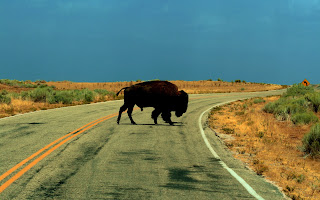General Info :
The American bison also commonly known as the American buffalo, is a North American species of bison that once roamed the grasslands of North America in massive herds, became nearly extinct by a combination of commercial hunting and slaughter
in the 19th century and introduction of bovine diseases from domestic
cattle, and has made a recent resurgence largely restricted to a few
national parks and reserves.
Two subspecies or ecotypes have been described: the plains bison (Bison bison bison), smaller in size and with a more rounded hump, and the wood bison (Bison bison athabascae)—the larger of the two and having a taller, square hump.
Two subspecies or ecotypes have been described: the plains bison (Bison bison bison), smaller in size and with a more rounded hump, and the wood bison (Bison bison athabascae)—the larger of the two and having a taller, square hump.
Physique :
A bison has a shaggy, long, dark brown winter coat, and a lighter weight, lighter brown summer coat. As is typical in ungulates,
the male bison are slightly larger than the female and, in some cases,
can be considerably heavier. Plains bison are often in the smaller range
of sizes, and Wood bison in the larger range. Head-and-body length
ranges from 2 to 3.5 m (6.6 to 11.5 ft) long, the tail adding 30 to 91
cm (12 to 36 in). Shoulder height in the species can range from 152 to
186 cm (60 to 73 in). Typical weight can range from 318 to 1,000 kg (700
to 2,200 lb).
Diet :
Bison are herbivores, grazing on the grasses and sedges of the North American prairies.
Their daily schedule involves two-hour periods of grazing, resting and
cud chewing, then moving to a new location to graze again.
Distribution :
Their historical range roughly comprised a triangle between the Great Bear Lake in Canada's far northwest, south to the Mexican states of Durango and Nuevo León, and east to the Atlantic Seaboard of the United States (nearly to the Atlantic tidewater in some areas) from New York to Georgia and per some sources down to Florida.
American bison live in river valleys, and on prairies and plains. Typical habitat is open or semi-open grasslands, as well as sagebrush, semi-arid lands and scrublands. Some lightly wooded areas are also known historically to have supported bison. Bison will also graze in hilly or mountainous areas where the slopes are not steep. Though not particularly known as high altitude animals, bison in the Yellowstone Park bison herd are frequently found at elevations above 8,000 feet and the Henry Mountains bison herd is found on the plains around the Henry Mountains, Utah, as well as in mountain valleys of the Henry Mountains to an altitude of 10,000 feet.
American bison live in river valleys, and on prairies and plains. Typical habitat is open or semi-open grasslands, as well as sagebrush, semi-arid lands and scrublands. Some lightly wooded areas are also known historically to have supported bison. Bison will also graze in hilly or mountainous areas where the slopes are not steep. Though not particularly known as high altitude animals, bison in the Yellowstone Park bison herd are frequently found at elevations above 8,000 feet and the Henry Mountains bison herd is found on the plains around the Henry Mountains, Utah, as well as in mountain valleys of the Henry Mountains to an altitude of 10,000 feet.


















No comments:
Post a Comment